I've been an avid collector of Elvis Presley memorabilia and autographs for more than 35 years. In the process I've managed to acquire numerous personal affects owned by Elvis, including large numbers of authenticated signatures on movie contracts, personal checks, letters and "in-person" signed documents and photographs for fans collected across the years.
Over the years I've seen and been offered literally hundreds, possibly thousands of "genuine" Elvis autographs - most of them fake.
That's not to say every would-be seller I've encountered has been a fraudster. Often the sellers themselves are duped into believing an item is authentic, before more detailed research and analysis is done later to reveal the item is in fact fake. As a fan and collector first, I'm always pleased to find genuine examples for sale, but also as a serious investor and representative for my clients I'm also keen to protect them from paying good money for an item that cannot be authenticated beyond any reasonable doubt.
With the explosion of eBay and other internet auction and e-commerce sites, the market and trade in fake Elvis items continues to grow exponentially. On the positive side, given Elvis's career long propensity to meet and greet with fans and generosity in providing autographs - it is still possible to find good examples of genuine signatures. You just need to know where to find them, and what to look for to determine authenticity.
Given the clear risk to fans and investors alike, I've decided to pass on the following guidance to help you in authenticating an Elvis Presley signature. This is based upon my own extensive experience and research conducted over decades of collecting. I'll use exemplars from my own personal collection, including some rarely seen important documents and personal items from Elvis's own collection as auctioned by Lisa Marie Presley and the Estate during the Guernsey's auction at the MGM Grand, Las Veges in 1999.
For cross-reference purposes, I'll also share samples that I can personally authenticate as being genuine; and will include some important examples of Elvis' handwriting - from my own private collection - and from documents already in the public domain e.g. on Elvis's Military documentation, on his Last Will And Testament, and famously in the handwritten letter to President Nixon in 1971 as publish by the FBI archives a few years ago.
Before considering purchasing Elvis Presley autographs please refer to the attached guide to support your own research. Alternatively for a small nominal fee I can do this on your behalf and provide an expert opinion or otherwise protect you before making your investment.
Before analysing the characteristics of Elvis Presley's handwriting and autograph exemplars, lets first of all consider the basics of autograph authentication
1 Origin & Traceability - The Who, What, When, and How ? The Items' source, it's ownership trail, and is this information supported by documented evidence ?
2 Identity & Association - Is the item intrinsically well known or easy to associate with a particular facet of the person's life, career or of some other particular significance ?
3 Trust - Does the item come from a recognised and respected source. Do you trust the seller. what are there credentials ?
4 Description - Is the item description accurate in documenting the artifacts origin and evidencing traceability. Do the people, places and dates all stack up ? Is the story of how the item was originally obtained and subsequently transferred between owners plausible ? Is there any corroborating evidence ?
5 Condition - Elvis has been gone for 30+ years. Hence all original items can be expected to show some signs of age however well protected. Is the condition consistent with similar artifacts of the period ?
6 Comparison with known exemplars - How does the item compare with known authenticated documents of the same type e.g. personal checks, contracts, letters, "in-person" signed autographs from the same contemporary time period.
First of all the good news is that Elvis was predisposed to provide autographs wherever and whenever he met with his adoring public. This is perhaps surprising to some given Elvis's stature in the entertainment field and is in stark contrast to some of his more notable contemporaries.
Elvis would often greet his fans at the gates of Graceland and at his other homes in Palm Springs and Beverley Hills; so there where a fair number of "in-person" opportunities for dedicated fans to obtain autographs and photographs. On occasion Elvis would welcome organised groups of fans into his dressing room & suite during engagements at the Las Vegas Hilton. There are other examples some well documented and even on film where fans obtained autographs at airports, at hotels and concert venues across North America.
A significant number of other items were signed during Elvis's military service posting in Germany (although this is an area known to be exploited by fraudsters), as well as in his brief excursions to Paris (on leave), and trip home via Prestwick Airport (Scotland).
Some of the hardest signatures to authenticate are those that have been faked deliberately freehand in a style designed to duplicate the original form of the autograph. Long before autopens had been in wide use, many vintage Hollywood stars were known to employ secretaries who were authorised to sign photographs and fan mail replies on their behalf. Frank Sinatra and Walt Disney are two examples where it can be sometimes difficult to establish provenance, especially in Mr. Sinatra's case recognising the wide variation of his signature across a long and illustrious career.
Elvis's office at Graceland are known to have signed letters, and thank you note replies back to fans etc. These items are referred to as "Secretarial" autographs to help satisfy the enormous number of requests in reply to fan mail.
Numerous examples abound of Hollywood dignitaries of the period using a similar method. Experts report in the case of JFK that
"you can tell if it was by secretary one, two or three".
More industrialised is the use of machines to replicate a signature multiple times from a given template. These are known as "Autopen" generated signatures and have been used e.g. extensively by NASA Apollo Astronauts and Royalty for many years to satisfy the huge demand for autographs.
There are no known "Autopen" examples of Elvis Presley's autograph. However what you will find is the use of "stock template" autographs provided by Elvis to use pre-printed on various items of merchandise and in particular album covers, photo albums and the like. These are fairly easy to spot and for the most part come from one or other of the following samples provided by the Graceland archives:
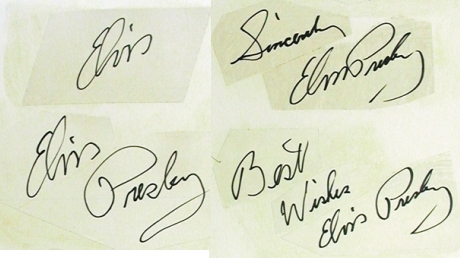
- The angle of the signature - could be unnatural or badly placed relative to the background.
- Pressure and speed of writing
- Bridges and tunnels in ink
- Rubber stamp "tramlines"
- Texture of the ink
- Autopen dots appearing at start and finish of strokes
Real people write their own name typically by placing the pen to paper and writing in one continuous movement of the pen. An autopen machine on the other hand (sic) touches the paper with a single dot before the pre-programmed template can start; and then ends equally abruptly (with a visible dot) when the machine is raised above the paper. Even if you can't detect these dots readily with the naked eye, they become apparent when magnified.
Autopens will tend to apply consistent pressure of pen to paper resulting in a uniformity of stroke and "boldness" which would be hard to match by the human hand. Conversely you will sometimes see autopen errors e.g. when the paper is moved slightly or the machine is interrupted; in this case unexpected horizontal changes will be generated resulting in "jagged" line strokes which wouldn't normally be found in the real thing.
Finally always remember that when signing their name, humans will tend to search for areas on the page where this is most contrast so as not to mask the handwriting i.e. dark pen on lighter areas, light pen on dark areas. Some autopen machine setups result in badly placed and e.g with many Apollo crew photographs autographs appearing in uniform and equally spaced positions. Note that in some cases 3 signatures can appear in different inks on the same document but all autopen examples nonetheless. Similarly, and confusingly real "in-person" autographs can be placed alongside autopen contemporaries - so you really need to check each sample separately.
Some fake autographs are easy to spot especially when there is an obvious physical discrepancy, or some other inconsistency with known facts. In particular, be careful to check the identity and publishing date of the originating article.
For example, since Elvis died on 16th August 1977 you won't find an authentic Elvis Presley signature on any CD or cover/inserts
When testing for machine generated reproductions on photographs, one crude yet effective method is to run your thumb over the signature. If you cannot detect a change in the surface texture of the ink on top of the photograph then its most likely a facsimile. Some more subtle techniques for identifying autopen signatures are explained elsewhere in this article.
There are so many issues with a Certificate of Authenticity (COA) its hard to know where to begin. In some cases a genuine attempt to document an authenticated item via a COA by a reputable dealer is itself forged or reused in some way to refer to another item of more dubious heritage. In this way the authentication issue becomes recursive !
Just remember a COA is just a piece of paper that anyone - you, I, a reputed dealer, a trusted source, amateur or indeed a fraudster can create at will. As such they simply cannot form any guarantee of authenticity. That said properly authored and used to document evidence and proof points they can provide valuable input to the authentication analysis; so don't discount them entirely.
More useful than the COA is the availability of a "lifetime moneyback guarantee"; should an artifact be subsequently shown to be fake. This means the onus is on the seller, who if they are confident of an items authenticity - will feel comfortable in providing an unequivocal guarantee.
A 100% authenticated signed document with indisputable provenance is intrinsically valuable to a fan, collector or investor. Value increases, if not multiplies if the article in question is associated with a particular significant event or facet of the artists life or career. The signed copy of Elvis's contract for the Film - Elvis: That's The Way It Is here is one such example:
Taking all of the above into consideration do not expect to find even a basic "cut" paper authentic Elvis Presley autograph for much less than USD $1,000. If something is offered to you that looks and feels to good to be true then it probably is. You may get lucky and pick up a bargain for less than this but be prepared to be disappointed unless you can authoritatively prove authenticity.
1 Be sceptical of COAs - COAs do NOT provide a guarantee of authenticity. To the contrary they are used by unscrupulous sellers to lure the buyer into a false sense of security.
2 Check Dates - Ask to confirm the publishing date on the reverse/cover of all publications, LP, Singles, EPs and the like
3 Do your own Research - Don't buy until you have satisfied yourself that the key authentication criteria explained above have been met. Review authenticated samples and known "Autopens" examples.
4 Consult with Experts - If necessary consult with recognised experts in the field.
5 Buy from reputable and accredited Autograph Dealers - Look for UACC / PADA / AFTAL Dealer Credentials
6 Seek a "Lifetime Moneyback Guarantee" - Reputable dealers will be happy to provide a moneyback guarantee without time limit if an autograph is subsequently found to be fake.
7 Contracts/Personal Checks/Handwritten Documents are harder to forge - Forgers tend to confine themselves to small "cut signatures" or adding their scribble on top of photographs, books, magazines etc. Larger documents, perhaps containing official stamps, or check cancellation marks, additional handwriting or annotations are intrinsically much harder to forge.
8 eBay: Check Seller Feedback & Ratings - Check for too many appearances of "rare" items; look for price anomalies versus the wider market (for investment grade items particularly).
9 eBay: Be wary of inaccurate item descriptions - A description could contain genuine mistakes, or more sinister inaccuracies; which immediately raise doubt as to any authentication claims
10 Trust your own instincts - If something sounds too good to be true, or it it just doesn't feel right - then trust your own judgement.
First comment I would make in examining Elvis's handwriting is to familiarise yourself with Elvis's forward slanted and somewhat erratic style. Here are some examples:
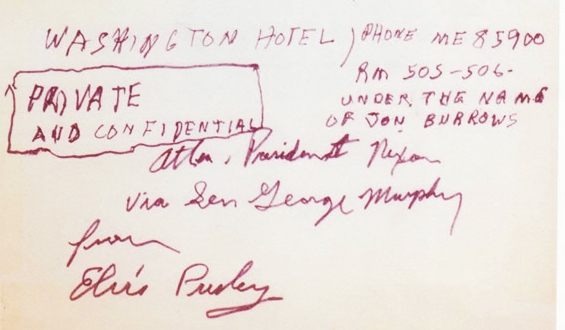
When signing autographs Elvis would often preface the name with "Best Wishes" or "Sincerely", and for fan dedications add "To" and "From" accordingly. See how the "T" resembles a "7" - which is a typical trait as seen in the following authenticated examples:
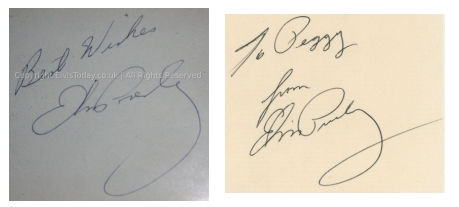
Assuming you have some empirical supporting evidence by way of documentation and/or association with known facts, places and dates; and that the physics e.g. in terms of age and condition of the originating article then the following Top 10 tips in evaluating the handwriting itself become relevant:
1 Most often, and in particular for "in-person" obtained signatures; where space allowed Elvis would write his full name i.e. "Elvis Presley" on a single line.
2 On official documents, such as on early contracts and personal bank cheques, Elvis would often use an initial form of his name i.e."E. A. Presley" . Note that the "A" initial would typically be written as a "capital sized" small "a"; rather than the actual capital form of the letter "A".
3 The "P" in "Presley" would tend to be the dominant letter and would be more extravagant in size and loop shape relative to the other letters.
4 The "Y" in Presley is always distinctive with a wide loop and different trailing characteristics depending upon presumably how rushed the signature or the amount of "clean" space on the document available.
5 On official documents, if not using the initial form (see point 2 above), Elvis would tend to be quite disciplined in providing a full signature - and most if not all letters of both "Elvis" and "Presley" would be clearly distinguishable.
6 Looking at the signature itself and how it flows - the word composition is typically read as "ElvisP" "resley" i.e. "s" in Elvis being joined to the "P" in Presley which in turn is separated from the "resley".
7 Elvis would rarely dot is "i".
8 The "E" in Elvis often contains a loop in the centre left position between both halves of the "E", and is often accompanied by a loop at the top as Elvis first puts pen to paper.
9 Elvis would sometimes write short notes to friends and associates with whom he was somewhat intimate and sign them with his initials "EP" or "E.P", but never with "E.A.P"
10 Compare your candidate signature, with known authenticated examples like those found here at ElvisToday; and if in doubt feel free to contact us for an expert opinion.
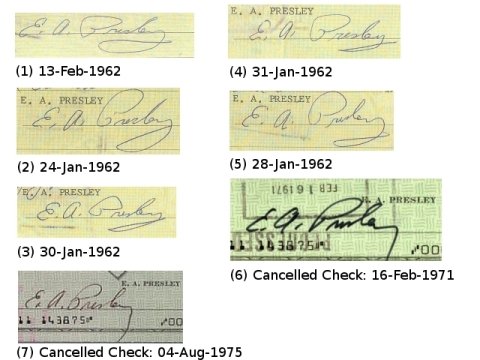
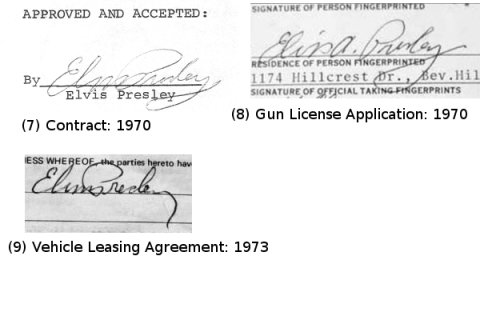
If you are searching for examples of individual letters in prose take a look at the following document samples:
Finally if in doubt seek help from an expert before parting with your money.
Remember that Certificate's Of Authenticity (COA) are only relevant if they are given on the basis of empirical proof as to authentication.
Good luck with your search for authentic articles and remember "Sanuk" in following your passion for collecting.
Regards and Taking Care of Business (TCB),
Garry A. Gomersall (
Copyright © 2009 by the author and elvistoday.co.uk. All Rights Reserved


